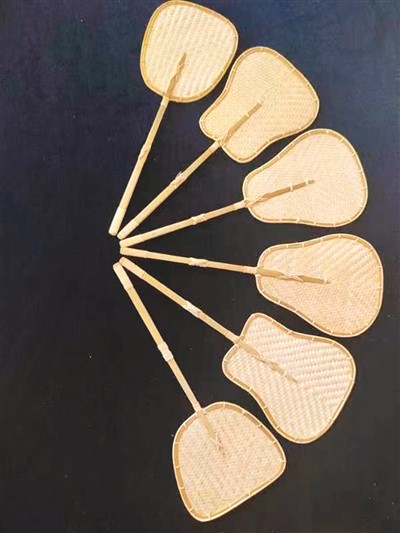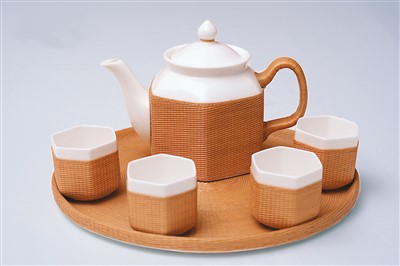Chinese bamboo weaving master promotes traditional craft through innovation
A bamboo weaving master in southwest China’s Sichuan Province has spent years committed to the inheritance of bamboo weaving, dedicating himself to improving the traditional craft through innovation.
Zhang Deming is a provincial-level crafts and arts master in Sichuan and an inheritor of Qingshen bamboo weaving, a national intangible cultural heritage item found in Qingshen county, known as the hometown of China’s bamboo weaving art, in Meishan city.

Photo shows bamboo fans made by Zhang Deming, drawing inspiration from cultural relics. (People’s Daily Overseas Edition/courtesy of the interviewee)
Born into a family engaged in bamboo weaving for generations, he learned bamboo weaving skills when he was 4 years old, and began making money by weaving bamboo into fans in his middle school days.
In the craftsman’s skilled hands, after more than 10 steps, the green bamboo is cut into thin and soft strips, a necessary preparation for the weaving process. Then, he uses bamboo strips to weave bamboo wares with porcelain bodies inside, which are both functional and decorative.
Zhang’s bamboo wares with porcelain bodies inside are also elegant with classical simplicity and novel with a stylish appeal, and are a fine example of how traditional Chinese culture can be combined with global fashions. For more than a decade, Zhang and his team have delivered orders worth over 100 million yuan (about $14.33 million) to a world-renowned brand.
Many of Zhang’s works have been selected as national gifts for the Asian Games in 1990 and the Summer Olympics in 2008 in Beijing and foreign leaders, and have won awards at home and abroad.
Over the past several decades, Zhang has embraced innovation in his bamboo weaving. He developed one method that was granted a patent, making his bamboo weaving products works of art. “Innovation is crucial to the inheritance of traditional crafts,” Zhang said.

Photo shows bamboo wares with porcelain bodies inside made by Zhang Deming. (People’s Daily Overseas Edition/courtesy of the interviewee)
Zhang also applies strict quality standards to his bamboo weaving products. On one occasion, a craftsman working for Zhang made a mistake and used bamboo strips with a width of 0.45 mm to weave tea trays for a world-renowned brand, which required the use of strips with a width of 0.43 mm. When Zhang found out, he asked the craftsman to do it all over again to meet the brand’s demands.
Meanwhile, Zhang has introduced bamboo weaving art to primary and secondary schools, vocational schools and universities, and promoted the craft by taking the opportunity presented by the integration of culture and tourism.
“Putting artworks of several bamboo weaving masters in museums is not enough to inherit and carry forward the bamboo weaving art. We need to introduce the art to millions of households by combining traditional skills with modern design and embracing innovation,” Zhang said.
Photos
Related Stories
- Inheritor of bamboo weaving integrates intangible cultural heritage with rural revitalization
- Young woman in Guizhou inherits bamboo weaving, helps generate wealth for local people
- Skilled bamboo weaver strives to revive intangible cultural heritage
- Pic story: inheritor of bamboo weaving eager to promote cultural heritage
- Chinese bamboo weaving master dedicates himself to traditional craft
Copyright © 2022 People's Daily Online. All Rights Reserved.









